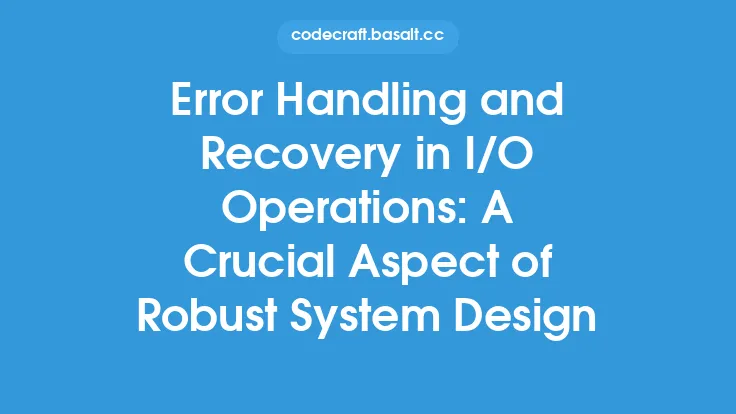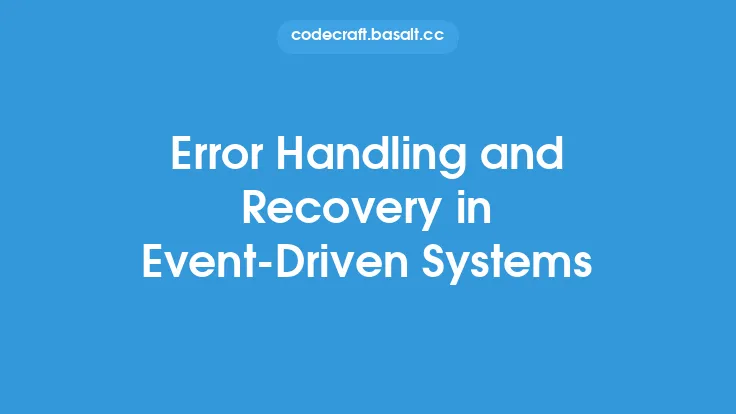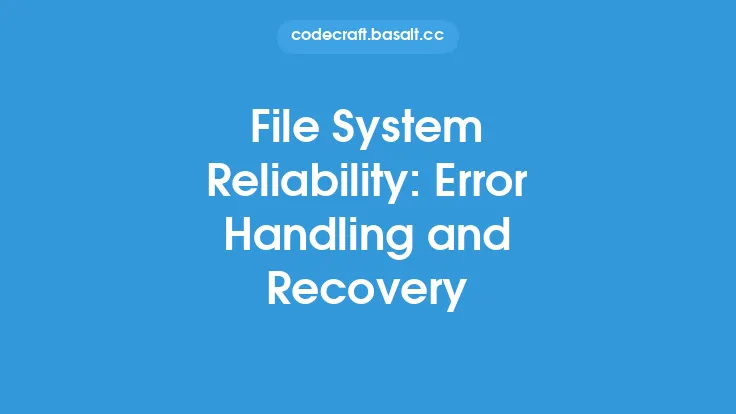Error handling and recovery are crucial aspects of device management in operating systems. Devices can fail or behave erratically due to various reasons such as hardware faults, software bugs, or external factors like power outages or user errors. When a device fails, it can lead to system crashes, data loss, or other undesirable consequences. Therefore, it is essential to have robust error handling and recovery mechanisms in place to minimize the impact of device failures and ensure system reliability.
Importance of Error Handling and Recovery
Error handling and recovery are vital components of device management because they enable the system to detect and respond to device failures, preventing them from causing more extensive damage. A well-designed error handling and recovery mechanism can help to:
- Prevent system crashes and data loss
- Minimize downtime and ensure system availability
- Reduce the risk of data corruption and ensure data integrity
- Provide useful error messages and diagnostic information to aid in troubleshooting
- Enable the system to recover from device failures and resume normal operation
Types of Errors in Device Management
There are several types of errors that can occur in device management, including:
- Hardware errors: These occur when a device fails due to a hardware fault, such as a faulty component or a power failure.
- Software errors: These occur when a device driver or other software component fails due to a bug or other issue.
- External errors: These occur when a device is affected by an external factor, such as a power outage or user error.
- Communication errors: These occur when there is a problem with communication between the device and the system, such as a faulty cable or incorrect configuration.
Error Handling Mechanisms
Error handling mechanisms are used to detect and respond to device failures. Some common error handling mechanisms include:
- Error codes: These are numerical codes that are returned by a device or driver to indicate the type of error that has occurred.
- Error messages: These are text messages that are displayed to the user to provide information about the error that has occurred.
- Interrupt handlers: These are routines that are executed in response to a device interrupt, such as a disk completion interrupt.
- Exception handlers: These are routines that are executed in response to an exception, such as a page fault or division by zero.
Recovery Mechanisms
Recovery mechanisms are used to restore the system to a stable state after a device failure. Some common recovery mechanisms include:
- Retry mechanisms: These involve retrying a failed operation to see if it will succeed the second time.
- Failover mechanisms: These involve switching to a redundant device or system component to ensure continued operation.
- Rollback mechanisms: These involve rolling back to a previous state or configuration to recover from a failed operation.
- Restart mechanisms: These involve restarting the device or system to recover from a failure.
Implementing Error Handling and Recovery
Implementing error handling and recovery mechanisms in device management involves several steps, including:
- Identifying potential error sources: This involves identifying the types of errors that can occur and the devices or system components that are most likely to fail.
- Designing error handling mechanisms: This involves designing error handling mechanisms, such as error codes and interrupt handlers, to detect and respond to device failures.
- Implementing recovery mechanisms: This involves implementing recovery mechanisms, such as retry and failover mechanisms, to restore the system to a stable state after a device failure.
- Testing and validation: This involves testing and validating the error handling and recovery mechanisms to ensure that they are working correctly.
Best Practices for Error Handling and Recovery
Some best practices for error handling and recovery in device management include:
- Using standardized error codes and messages to provide consistent error information
- Implementing retry mechanisms to handle transient errors
- Using failover mechanisms to ensure continued operation in the event of a device failure
- Providing detailed diagnostic information to aid in troubleshooting
- Testing and validating error handling and recovery mechanisms thoroughly to ensure that they are working correctly
Common Error Handling and Recovery Techniques
Some common error handling and recovery techniques used in device management include:
- Timeout detection: This involves detecting when a device or operation has timed out and taking corrective action.
- CRC checking: This involves checking the cyclic redundancy check (CRC) of data to detect errors.
- ECC correction: This involves using error-correcting code (ECC) to correct errors in data.
- Redundancy: This involves using redundant devices or system components to ensure continued operation in the event of a failure.
Conclusion
Error handling and recovery are critical components of device management in operating systems. By implementing robust error handling and recovery mechanisms, system designers and developers can minimize the impact of device failures and ensure system reliability. By following best practices and using common error handling and recovery techniques, developers can create reliable and fault-tolerant systems that provide high levels of availability and data integrity.





